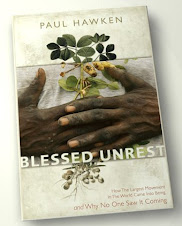Carbon Neutral on a Shoestring - from the Home and Garden section of The New York Times, published March 4, 2009Petz Scholtus has been largely successful in retrofitting an 18th-century apartment in Barcelona as a green machine. Photo by Stefano Buonamici for The New York Times.
THE floor tiles made from smashed television screens did not, in the end, work out. Neither did the pulley system Petz Scholtus’s boyfriend rigged to haul her stuff up three very steep flights of stairs to her new apartment in the Barri Gòtic, or old city, when she moved in over a year ago. But the move itself — by bicycle through the streets of the oldest and most cinematic neighborhoods here — was a carbon-neutral success. (It helped that Ms. Scholtus had no furniture then.) So, too, were other elements of her eco-renovation.
That is the phrase Ms. Scholtus, a 28-year-old product designer from Luxembourg, has been using to describe the ongoing restoration and decoration of a one-bedroom apartment in the 18th-century building where she lives and works. In Barcelona, a city that has long prized the new and the glossy, Ms. Scholtus’s project amounts to a countercultural effort.
“Here people have an idea that sustainable is for the rich or that it’s something horrible and low-quality hippy,” Ms. Scholtus said. “I wanted to see if it was possible to make it inexpensive but also, you know, cool.”
As Americans fumble with their green goals and begin to cast a critical eye on sustainable practices on many levels — from a cap on industrial emissions to the use of fluorescent light bulbs — Ms. Scholtus’s experiences (which she recounts on her blog, r3project.blogspot.com) are an object lesson in how fully one can realize green ideals on a budget in an existing home in any city.
On a dark, raw February morning, Ms. Scholtus’s apartment was bright, if not exactly toasty, from the fluorescent bulbs tucked into her handmade Bidon lamps. The English translation of bidón is jerry can or container; Ms. Scholtus found a few on the street and fitted them with compact fluorescent bulbs and PVC-free wiring. One was hanging over a door frame; another sat on a rug like a small pet.
There was a voluminous beanbag chair made from recycled car-seat fabric by a company called Waste; a planter made from an old tire; a chair found nearby at the Placa George Orwell and decoupaged by Ms. Scholtus with newspapers; and floor-to-ceiling stenciled shelving made from fiberboard (planks of recycled sawdust) certified by the Forest Stewardship Council and painted with pigments low in volatile organic compounds (V.O.C.’s). On the terrace, worms were quietly gnawing through Ms. Scholtus’s kitchen scraps, making compost for her herb garden.
Ms. Scholtus, who grew up on a farm in Luxembourg and studied eco-design at the University of London, arrived in Barcelona five years ago. She was teaching English and eco-design, creating products (collapsible felt storage containers called Stuff Bumps, developed in partnership with the green resource and news blog TreeHugger, for whom she is a contributor), art installations and other projects for folks like Chicks on Speed, a German electropop art band.
Rents were high, but purchase prices in the Barri Gòtic, where the newest buildings date from the 18th century and require extensive renovation, were relatively low. Still, this apartment, which Ms. Scholtus bought for 235,000 euros in 2006 (just under $300,000), was hardly a steal: it had no plumbing, no electricity; no glass in its windows; the toilet was in a closet on the terrace; and what would become the bedroom was closed off by a bearing wall (the only entrance was from the terrace). The massive ceiling beams were pocked from wood lice and encrusted with paint in many colors, layered in over the centuries.
Because Ms. Scholtus had challenged herself to be environmentally responsible during every stage of home ownership, she began by researching green financing. To buy the place, she obtained a mortgage from what is known as an ethical bank. Ethical banks — a rara avis in this country (they are more common in Europe and Canada) — invest only in socially or ecologically responsible businesses and projects.
Triodos, a European ethical bank established in 1980, had just opened a branch in Barcelona. Sonia Felipe Larios, a spokeswoman for Triodos Spain, described its core business as financing “companies and organizations from the social, cultural and environmental sectors,” citing organic farming, sustainable tourism, welfare and fair trade organizations as examples.
Ms. Scholtus’s loan, Ms. Felipe Larios said, was a departure for the bank, “the first eco-mortgage we have given here.” Technically, the bank extended Ms. Scholtus a professional loan, as if she were a company or an organization.
“We are still developing residential products in Spain,” Ms. Felipe Larios said. “She was very proud of what we’ve been doing, and we’re very proud of what she’s done in her home.”
Ms. Scholtus became an apartment owner on Buy Nothing Day, an anti-consumerist holiday celebrated in the United States the day after Thanksgiving and 24 hours later elsewhere. The coincidence, she said, made her feel ill. “I called Graham Hill,” Ms. Scholtus said, referring to the founder of TreeHugger, “and he said, ‘For goodness sake don’t put that on TreeHugger.’ ”
IN making her new home livable, Ms. Scholtus’s challenge to herself was to hew as closely as possible to the three R’s of environmentalism: reduce, reuse, recycle. (Restore and respect are the other R words listed on her blog, but she liked R3 as a title for the project because her street address is 3.) Could she find products that were made close to home, were produced without a huge environmental impact, could be dismantled after her tenancy (following the cradle-to-cradle recycling model) and did not use too much energy? Oh, and all for under 30,000 euros (about $38,000)?
There were hits and misses, but the budget didn’t waver.
One miss: The smashed-television-screen floor tiles she found for the kitchen and bathroom in off-white turned out to be a sickly beige. When she phoned the company that sold them to her, she was told that the color she had chosen was no longer being made. She quickly found ceramic tiles made by a local company that had its own water-treatment plant — that was the good part. But because they were ceramic, they could only be installed with grout — in other words, the old-fashioned permanent way, not ideal for a cradle-to-cradle proponent.
“The only way to remove them is to smash them,” Ms. Scholtus explained.
To save on rent during the demolition, she embarked on six months of couch surfing and house-sitting, working from her laptop and wearing summer clothes long past August.
She found a contractor who claimed to be a green builder. Unfortunately, as she discovered later, just before she fired him, the green projects in his portfolio had been cut from magazines and represented the work of other builders.
“I was going to be the real example for his portfolio,” she said. In over his head, the contractor was relieved to be let go, she continued. Truth be told, he had handled the demolition part just fine, sandblasting the woodwork (a nontoxic alternative to using chemical strippers), hauling out the rubbish and obtaining the environmentally friendly materials that Ms. Scholtus had located (like cork flooring that fits together like a jigsaw puzzle, without glue).
An electrician from Colombia became her lieutenant and then her full-time contractor, though he initially mocked her instructions to find things like PVC-free pipes for the new plumbing (PVC, or polyvinyl chloride, is a ubiquitous building material; environmentalists are concerned about toxic emissions during its manufacture and disposal.).
“In the beginning, he couldn’t understand why I’d go through the trouble of finding PVC-free pipes when the standard PVC ones are easy to find and very cheap,” she said. “In the end, he got into it, and asked me, ‘Is this sustainable?’ or ‘Why is this not good?’ ”
Ms. Scholtus delights in making do with materials at hand. She and Mette Bak Andersen, a Danish designer who lives in Barcelona, have devised a workshop called Materialize Me that they hold at schools like the Elsivava Design School here and the Krabbesholm School in Denmark.
In the workshops, students are challenged to make products from materials that are close at hand, like leaves, scrap metal or their hair. At one workshop in Krabbesholm, a team scooped waste from a sewage treatment plant and made bricks out of it (“they were very brave,” Ms. Scholtus said admiringly); another team hacked CDs to bits and baked them into the shape of a classic Danish lamp.
Ms. Scholtus’s dining room table is a glass slab she found in the rubble of her apartment. “The workers kept complaining that it was too big to remove,” she said. So she found trestles on the street, painted them and placed them under the slab to make a table. Dismantled wine boxes await deployment as the doors to her Ikea kitchen cabinets; ancient drawers rescued from the street, which smell of incense — “I think they must have come from a church,” Ms. Scholtus said, wrinkling her nose — sit on casters and hold magazines.
To heat the apartment and the water, Ms. Scholtus purchased an efficient condensing gas boiler, which she tucked into the closet on her terrace where the toilet once lived. But only after researching a solar solution, her first choice.
“There are more solar panels per capita in Luxembourg than here,” she said, “and where is there more sun?” Ms. Scholtus’s apartment, however, is two floors below the building’s roof, so solar heating was not a viable option, according to a few companies she contacted.
She also dreamed of radiant floor heating, but its cost pushed her toward radiators. She chose Low-H2O radiators (which use two liters of water, rather than 20, a big energy saver), made by the stylish radiator company Jaga.
The other day, though, when an American visitor stopped by, none of them were in use. Spoiled by years of environmental indolence , the visitor shivered a bit. Ms. Scholtus, grinning in her sweater, offered her coffee, a European’s best retort to the energy crisis.Check out Petz Scholtus' amazing blog - with photos and instructive videos on how she is doing such an amazing job of renovating with an eye towards sustainability.
 I've only lived in a handfull of cities and towns, but I have to say that the folks who run Rainbow Cleaners in Oxford, Mississippi, are the nicest drycleaners I've ever dealt with. They are always pleasant, always helpful, always appear to be hard at work and aware of their customers. The owner is particiularly friendly and has asked me questions about other drycleaners I've been too, in an effort to find new ways to improve his own business.
I've only lived in a handfull of cities and towns, but I have to say that the folks who run Rainbow Cleaners in Oxford, Mississippi, are the nicest drycleaners I've ever dealt with. They are always pleasant, always helpful, always appear to be hard at work and aware of their customers. The owner is particiularly friendly and has asked me questions about other drycleaners I've been too, in an effort to find new ways to improve his own business.

















